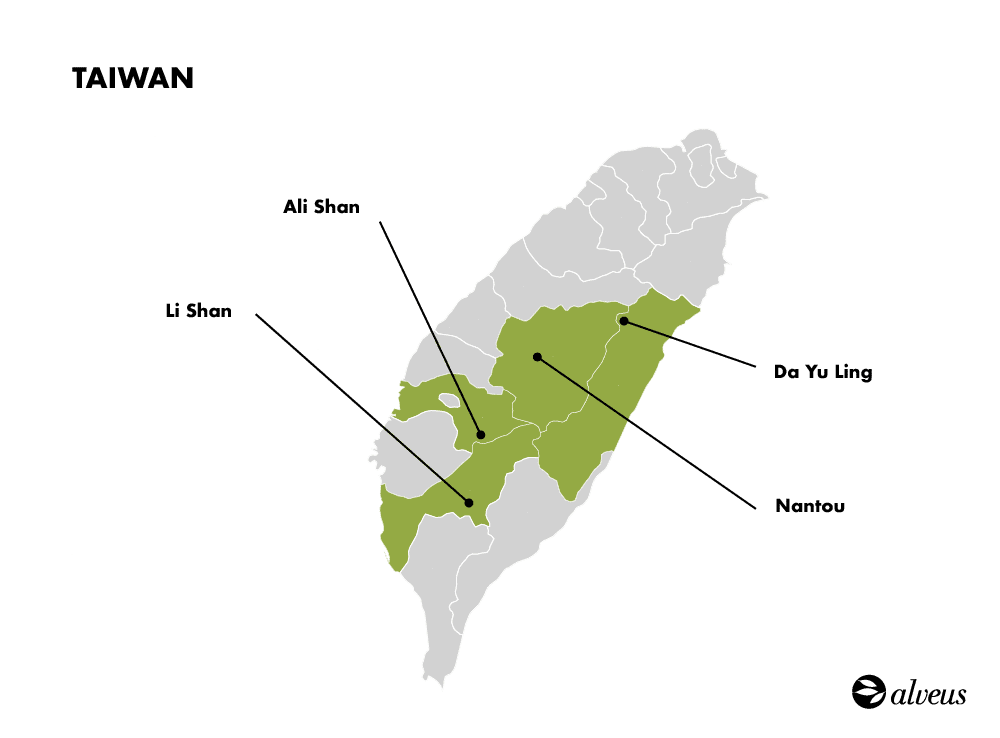Taiwan, an East Asian island historically known as “Ilha Formosa” (Beautiful Island) due to its stunning mountainous scenery, is now a global leader in tea production, especially for oolong teas.
Strategically located between the East China Sea and the South China Sea, Taiwan has developed a significant tea tradition despite facing political and climatic challenges.
The island’s mountainous geography, combined with a mild maritime climate, creates the ideal conditions for cultivating high-quality tea varieties. The absence of extreme weather and steady rainfalls allows tea bushes to thrive, resulting in a diverse range of flavours and aromas that define Taiwanese tea.
Moreover, Taiwan has firmly established itself as one of the world’s leading producers and consumers of oolong, blending ancient techniques with modern innovations.
The History of Taiwanese Tea
Taiwan’s tea history dates back to the 17th century when the first tea bushes were brought from China’s Fujian province. Taiwan’s proximity to Fujian allowed tea cultivation to quickly develop and evolve on the island.

During Japan’s occupation of Taiwan, which began in 1895, there was significant expansion in tea cultivation. The Japanese encouraged tea farming in the southern and western parts of the island, creating an infrastructure that enabled the industry to flourish.
After 1980, Taiwan experienced a third phase of tea industry development, when legislation allowed citizens to establish tea factories. This legal change spurred increased production and diversification, spreading tea cultivation further inland.
The combination of cultural heritage, traditional techniques, and modern innovations has allowed Taiwan to remain at the forefront of high-quality tea production.
Tea Growing Regions in Taiwan
Taiwan’s maritime climate and mountainous terrain offer optimal conditions for tea cultivation. The tea-growing regions span from lowlands to high mountains, each providing a unique microclimate that influences the tea’s flavour profile.
These mountainous regions, each with distinctive characteristics, bring unique nuances to the teas produced in Taiwan. Below, we explore the main Taiwanese tea-growing areas and how their unique features influence the quality and diversity of the island’s teas.

Ali Shan
Altitude: 1,100 to 2,500 meters
Located in Chiayi County, Ali Shan is one of Taiwan’s highest tea-growing regions, with plantations ranging from 1,100 to 2,500 meters above sea level. The teas produced here, such as the famous Ali Shan oolong, are cherished for their delicate, floral, and creamy notes.
Li Shan y Da Yu Ling
Altitude: Over 2,500 meters (8,200 feet)
These high-altitude regions are known for producing some of Taiwan’s most sought-after and expensive oolongs. With altitudes exceeding 2,500 meters, Li Shan and Da Yu Ling teas are recognized for their light, resinous flavour, with a sweet, floral aroma that is simply unparalleled.
Nantou
Altitude: 1,000 to 1,600 meters
Nantou County is home to ball-shaped oolongs and is known for its Jade and Dong Ding teas.
The persistent mists and cooler temperatures create a perfect environment for cultivating teas with intense aromas and complex flavour profiles.
Iconic Taiwanese Tea Varieties
Taiwanese tea is renowned worldwide for its quality and variety, with a particular focus on oolong—a partially oxidized tea that lies between green and black tea. Discover more about the oolong tea-making process in our blog post.
Now, let’s explore some of the most iconic Taiwanese tea varieties and their unique characteristics:
Champagne Oolong (Bai Hao Oolong / Oriental Beauty)
This tea, produced in the counties of Hsinchu, Taoyuan, and Miaoli, is a standout among Taiwan’s oolongs. It is characterized by a high oxidation level, around 70%, giving it a distinctive and complex flavour.
The open leaves and white tips of this oolong indicate its high quality. Its flavour profile is remarkably smooth and silky, with a natural sweetness that blends with a seductive orchid aroma. This floral character is comparable to the first flush of Darjeeling but with a more pronounced sweetness and less astringency.

You can find an example of this Oriental Beauty tea in our online store, Alveus, such as our Oriental Beauty Superior ORGANIC.

Jade Oolong (Green Oolong)
Jade Oolong, primarily grown in Nantou County, is a low-oxidation oolong (15-30%). This ball-shaped tea is known for its fresh aroma with floral notes like jasmine and orchids, and its delicate, slightly sweet flavour.
Additionally, the ball shape of the leaves allows for a gradual release of flavours during steeping, enabling multiple infusions that reveal different nuances over time.
Pouchong (Bao Zhong)
Pouchong is a lightly processed oolong with very light oxidation (10-15%), originating from the tea-growing areas around New Taipei City.
This tea is characterized by its twisted leaf and intense floral aroma, with notes of lily and sweet peas. Its aroma is so prominent that a special type of cup is used to enjoy the floral fragrance. This tea is best appreciated when fresh, as its floral bouquet can fade over time.
Dong Ding Oolong (Tung Ting Oolong)
Dong Ding Oolong, also known as Tung Ting Oolong, is one of Taiwan’s most prestigious teas. Its name, meaning “Frozen Summit,” refers to the cold and misty mountains where it is grown, around Mount Dong Ding in Nantou County.
This tea is distinguished by its ball-shaped leaves and moderate oxidation level, around 30%. This partial oxidation gives it a perfect balance between green and black tea profiles, offering a unique experience.
Dong Ding Oolong is known for its deep, floral aroma, with intense orchid notes and a hint of honey. Its liquor is smooth and sweet, with apricot undertones and a slightly toasted flavour.

Tie Guan Yin
This tea, produced in northern Taiwan, shares roots with the traditional Tie Guan Yin from Fujian, but with a distinctive Taiwanese twist that makes it unique.
Taiwanese Tie Guan Yins are often more roasted, offering a robust and complex flavour profile with pronounced notes of nuts and caramel.
This additional roasting process enhances its aroma, adding smoky undertones and a smooth mouthfeel that ends in a sweet, long-lasting finish, reflecting the skill and dedication of Taiwan’s tea masters.
Four Seasons Tie Guan Yin BIO is an example of Taiwanese Oolong tea from the Nantou region of the Tie Guan Yin variety, available in our B2B online store.
Jin Xuan (Milk Oolong)
Jin Xuan is a variety of oolong tea known for its creamy aroma and delicate floral flavour. This tea, which can be grown at various altitudes, reaches its best expression in high-altitude areas, where the cool climate and elevation help develop its characteristic flavour profile.
What truly sets Jin Xuan apart is its subtle milk flavour, a natural characteristic that results from the combination of its unique cultivar and a carefully controlled oxidation process.
While there are flavoured oolongs that mimic Jin Xuan’s profile with artificially added milk flavour, authentic Jin Xuan offers a natural creaminess, along with its floral notes.
Amber Oolong (Red Oolong)
This tea is known for its deep amber colour and sweet, caramel-like flavour, often reminiscent of a good dessert wine. The rich, honey notes of Amber Oolong result from its high oxidation level, which falls between oolong and black tea.
Produced in the Luye and Hualien areas, Amber Oolong is gaining popularity for its rich, full-bodied flavour, which pairs well with desserts or can be enjoyed on its own.
Conclusion
Taiwanese tea is a testament to the island’s rich cultural heritage, exceptional craftsmanship, and ideal growing conditions.
From the delicate and floral Jade Oolong to the rich and creamy Jin Xuan, Taiwanese teas offer a diverse array of flavours and aromas that cater to every palate.
Whether you’re an experienced tea connoisseur or a casual drinker, there’s a Taiwanese tea variety for everyone.
Discover the art and science behind these exquisite teas and enjoy the unique taste of Taiwan in every cup.










